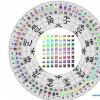Emily Dickinson s poetry abounds in images. In the
Emily Dickinson s poetry abounds in images. In the best of her poems every word is a picture seen. Comment on the images in either "Because I Could Not Stop for Death" or "I Like to See It Lap the Miles".
请帮忙给出正确答案和分析,谢谢!
参考解答
正确答案:Because I Could Not Stop for Death is one of Emily Dickinson' s very popular poems in which she portrays Death as a central image—a gentleman caller or as a suitor. The event is couched in a metaphorical use of an activity familiar enough to men and women of the nineteenth century—a formal but friendly drive in a carriage in the country of a gentleman and his intended lady. The gentleman in question however is Death himself; and the lady is an imagined persona of the poet. The whole poem and other images are extended from this image. The poem is a dramatic representation of the passage from this world of the living to the afterlife.In the first stanza the gentleman has called on persona as a beau; and like a true gentleman he has included 'Immortality' as an image of a chaperone. The second stanza indicates the peacefulness and pleasantness surrounding an appointment with a beau. By the third stanza they are nearing the edge of town. Rich images are used. The seemingly disparate elements of children 'Gazing Grain' and 'Setting Sun' the sensations that dying lady experiences are transferred to these parts of the world. She is gazing and the notion is transferred to the grain; she is ' setting' and this notion is transferred to the sun. The mention of children ' striving' at recess is a subtle preparation for the stasis or lack of motion described in the succeeding images. In addition the three elements summarize the progress and passage of a lifetime. It includes the three states of youth maturity and age the cycle of day from morning to evening and even a suggestion of seasonal progression from spring through ripening to decline.In the fourth stanza the lady is getting closer to death; for 'The Dews' now grow 'quivering and chill' upon her skin the traditional associations of the coldness of death. Her tippet made of lace is something one might expect to see around the shoulders of a deceased woman lying in repose. In the fifth stanza they have arrived at a country cemetery. The House is a fresh grave. The roof is a small tombstone; and the cornice the molding around a coffin' s lid is already placed 'in the Ground'. The lady is alone now; her gentleman friend has vanished unexplained. In the sixth stanza it was not until after the school children the ' Gazing Grain' the 'Setting Sun' and the 'Swelling of the Ground' that she began to realize where she was heading. She had therefore apparently been tricked seduced and then abandoned.
BecauseICouldNotStopforDeathisoneofEmilyDickinson'sverypopularpoemsinwhichsheportraysDeathasacentralimage—agentlemancallerorasasuitor.Theeventiscouchedinametaphoricaluseofanactivityfamiliarenoughtomenandwomenofthenineteenthcentury—aformalbutfriendlydriveinacarriageinthecountryofagentlemanandhisintendedlady.Thegentlemaninquestion,however,isDeathhimself;andtheladyisanimaginedpersonaofthepoet.Thewholepoemandotherimagesareextendedfromthisimage.Thepoemisadramaticrepresentationofthepassagefromthisworldofthelivingtotheafterlife.Inthefirststanzathegentlemanhascalledonpersonaasabeau;and,likeatruegentleman,hehasincluded,'Immortality'asanimageofachaperone.Thesecondstanzaindicatesthepeacefulnessandpleasantnesssurroundinganappointmentwithabeau.Bythethirdstanza,theyarenearingtheedgeoftown.Richimagesareused.Theseeminglydisparateelementsofchildren,'GazingGrain',and'SettingSun',thesensationsthatdyingladyexperiences,aretransferredtothesepartsoftheworld.Sheisgazing,andthenotionistransferredtothegrain;sheis'setting',andthisnotionistransferredtothesun.Thementionofchildren'striving'atrecessisasubtlepreparationforthestasis,orlackofmotion,describedinthesucceedingimages.Inaddition,thethreeelementssummarizetheprogressandpassageofalifetime.Itincludesthethreestatesofyouth,maturity,andage,thecycleofdayfrommorningtoevening,andevenasuggestionofseasonalprogressionfromspringthroughripeningtodecline.Inthefourthstanza,theladyisgettingclosertodeath;for'TheDews'nowgrow'quiveringandchill'uponherskin,thetraditionalassociationsofthecoldnessofdeath.Hertippetmadeoflaceissomethingonemightexpecttoseearoundtheshouldersofadeceasedwomanlyinginrepose.Inthefifthstanza,theyhavearrivedatacountrycemetery.TheHouseisafreshgrave.Theroofisasmalltombstone;andthecornice,themoldingaroundacoffin'slid,isalreadyplaced'intheGround'.Theladyisalonenow;hergentlemanfriendhasvanishedunexplained.Inthesixthstanzaitwasnotuntilaftertheschoolchildren,the'GazingGrain',the'SettingSun',andthe'SwellingoftheGround'thatshebegantorealizewhereshewasheading.Shehad,therefore,apparentlybeentricked,seduced,andthenabandoned.
相似问题
Who are the three dominant figures of the American
Who are the three dominant figures of the American Realistic Period and what are their literary differences?请帮忙给出正确答案和分析,谢谢!
What is the name of the novelist?请帮忙给出正确答案和分析 谢谢!
What is the name of the novelist?请帮忙给出正确答案和分析,谢谢!
Transcendentalism请帮忙给出正确答案和分析 谢谢!
Transcendentalism请帮忙给出正确答案和分析,谢谢!
Realism请帮忙给出正确答案和分析 谢谢!
Realism请帮忙给出正确答案和分析,谢谢!
Who is the author of the essay?请帮忙给出正确答案和分析 谢谢!
Who is the author of the essay?请帮忙给出正确答案和分析,谢谢!












